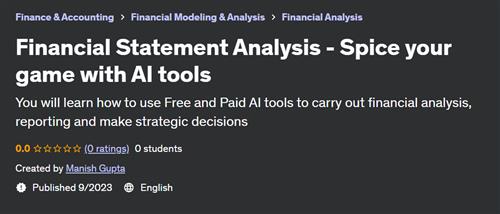
Financial Maths Bootcamp
Posted on 09 Mar 10:21 | by AD-TEAM | 44 views

Financial Maths Bootcamp
Duration: 4h 7m | .MP4 1280x720, 30 fps(r) | AAC, 44100 Hz, 2ch | 3.43 GB
Genre: eLearning | Language: English
Introduction to core financial maths techniques and terminology needed to make sense of how financial markets work
What you'll learn:
On completion you will have a solid understanding of many of the fundamental techniques used by financial markets participants.
The course takes a step by step approach to building your knowledge so providing the platform to apply that knowledge in practice
Whether it's Time Value of Money, probability distributions, volatility, beta etc., you will be able to evaluate and analyse data in a rational usuable manner
Your understanding and analysis in areas such as pricing and valuation, risk and return, will allow for a greater appreciation of drives financial markets
Requirements:
Enthusiasm
A willingness to learn
A spreadsheet
The maths you learnt at school (you definitely don't have to be a maths genius!)
Description:
There is no getting around the fact that working in financial markets comes with the need to have some understanding of maths, if you really want to make a success of it.
The ability to collect, organise, evaluate and analyse data is the key to understanding the value of assets and their associated risk. Armed with this ability, we can make rational decisions. not just financial ones, but, those that affect many other aspects of our lives.
it doesn't matter whether you work in, sales and trading, asset management, risk, personal investing, corporate finance, or which product you deal with, bonds, equities, derivatives or commodities; the same techniques are common to all.
And here's the good news. Contrary to popular belief, the maths is not that difficult!!!
In 4.50 hours and 8 modules, the course covers the maths needed to get you started on your journey.
The course videos are short, subject matter is broken down into digestible parts, all the terminology and methodology is explained with examples using clearly set out spreadsheets.
Module 1 Interest Rates
We've all heard the term. But, what's the difference between a Nominal rate, Simple rate, Effective rate, continuously compounded rate and period rate? This module looks at each of these, compares and contrasts them, and defines the convention used when we see an interest rate quote.
Module 2 Calculating Returns
Calculating the returns on investments can be done in a number of ways; for the period that we held it or, more usually, on an annual basis, or on an inflation adjusted basis (real return). Furthermore, they can be calculated on a discrete or continuously compounded basis.
We look at these various ways, with explanations and examples of how to calculate them.
Module 3 Time Value of Money
This one is the real deal. Time Value of Money is one of the most important concepts in business and finance. Its principles are at the heart of understanding value and therefore, making rational investment decisions. It provides clarity to most of the what is going on in the financial world.
And the best thing about it is that it's not that hard to understand.
Module 4 Measures of Central Tendency and Dispersion
This one is a recap of the statistics you probably did at school. We look at measures of central tendency, mean, mode and median as well as measures of dispersion such as range and standard deviation (the first introduction to the concept of risk).
Module 5 Probability Distributions
How often had you heard someone say 'equity markets are too high, they're going to crash', or 'We expect equities to provide a 10% return in the coming year.' Rarely will there be a mention of the chances of either of those happening, or not.
Probability distributions allow us to quantify the chances of an expected outcome.
There are numerous types of distributions. Here we look at two of the most common ones, normal distributions and lognormal distributions.
Module 6 Volatility
Risk and return are two of the things we need to consider when investing. When we invest we expect a return, but, we also have to accept the risk of things not working out as expected.
Risk is one of the key metrics in evaluating investments. To achieve high returns we usually have to take on high risk, Conversely, if you are risk averse, then you cannot usually expect a high return As they say, 'There is no such thing as a free lunch.'
Volatility is a proxy for risk. Here we look at the different types of volatility and how volatility is measured and calculated.
Module 7 Moving Averages
Should we buy or should we sell?
Moving averages are a way of smoothing price changes over time and potentially allow for the identification of trends.
The construction and uses of Simple and Exponentially weighted moving averages are explained here.
Module 8 Relationships Between Assets
When constructing a portfolio, hedging against adverse price movements or establishing a trading strategy with two or more securities, an analysis of whether securities move in the same direction or not, is essential.
This is where covariance, correlation, regression and beta come into play.
Asset managers try to construct portfolios that provide the maximum expected return for the lowest level of risk. Some hedge funds pursue long/short strategies.
All involve the use of the simple statistical techniques above.
This module describes them, shows how to do the calculations as well as highlighting some of the pitfalls of using them.
Who this course is for:
Anyone undertaking a financial degree.
New or prospective investment banking hires and interns.
Anyone with an interest in how financial markets work.
Anyone wanting an insight into the fundamentals terminology and application of financial maths techniques.
Anyone interested in investing and trading.
More Info
Download from RapidGator
https://rapidgator.net/file/0dd91831b2265735559012fd414b8b09/....Financial.Maths.Bootcamp.part1.rar
https://rapidgator.net/file/f1c7386237c80380f626110ad04e51b9/....Financial.Maths.Bootcamp.part2.rar
https://rapidgator.net/file/f27a996cf9fcb737b794ed8f4f02d463/....Financial.Maths.Bootcamp.part3.rar
https://rapidgator.net/file/dbe03e7acee9d9a2ebd08b6b94b7f0e0/....Financial.Maths.Bootcamp.part4.rar
Download from banned-scamhost
https://nitro.download/view/947BEF0824FF61A/....Financial.Maths.Bootcamp.part1.rar
https://nitro.download/view/828860176215CA0/....Financial.Maths.Bootcamp.part2.rar
https://nitro.download/view/93ABB569CEAB5D9/....Financial.Maths.Bootcamp.part3.rar
https://nitro.download/view/8286BF10CB7F6C4/....Financial.Maths.Bootcamp.part4.rar
Related News
System Comment
Information
 Users of Visitor are not allowed to comment this publication.
Users of Visitor are not allowed to comment this publication.
Facebook Comment
Member Area
Top News



